Experimental Study on Performance Enhancement of a Photovoltaic Module Incorporated with CPU Heat Pipe—A 5E Analysis
Abstract
:1. Introduction
2. Materials and Methods
2.1. Heat Pipe Theory and Operation
- The evaporation of the working fluid is enabled by the heat added at the evaporator portion by conduction through the wall of the heat pipe.
- Movement of vapor from the evaporator section to the condenser section occurs; this is influenced by the vapour pressure drop occasioned by the working fluid evaporation.
- In the condenser part, the vapour condenses, releasing its latent heat of evaporation.
- The liquid moves back to the evaporator section from the condenser section through the wick using capillary force and liquid pressure drop.
2.2. Construction of Experimental Test-Rig
2.3. Energy Analysis
2.4. Exergy Analysis
2.5. Economic Analysis
2.6. Energy Payback Time (EPBT)
2.7. Uncertainty Analysis and Experiment Measurement Assessments
3. Results and Discussion
3.1. Weather Characteristics of the Experimental Period
3.2. Performance of FanLess CPU Heat Sink on the PV Panels
3.2.1. Effect of Temperature on PV Panels
3.2.2. Electrical Performance of a PV Panel
3.3. Electrical Efficiency
3.4. Exergy Efficiency
3.5. Economic Analysis
3.5.1. Scenario 1 for 105 Days
3.5.2. Scenario 2 for 365 Days
3.6. Energy Payback Time
4. Conclusions
- (1)
- The average temperature of a cooled PV panel for the experimental period is 40.76 °C, while that of the referenced PV panel is 47.49 °C. Thus, a temperature reduction of 6.73 °C was obtained as a result of the cooling of the PV module.
- (2)
- The average voltage and current for the cooled PV panel during the experimental day are 18.36 V and 0.619 A, while those for the uncooled PV panel are 17.01 V and 0.57 A, respectively.
- (3)
- The average power output recorded for the cooled PV panel is 11.39 W and 9.73 W for the reference panel. The overall improvement in the production of power is 1.66 W.
- (4)
- The average exergy efficiency difference between for a cooled and an uncooled PV panel is 3.34%.
- (5)
- results that for the first scenario, i.e., 105 days, for the cooled PV panel would be 0.96 USD/kWh against 0.61 USD/kWh for the uncooled module. Furthermore, in the case of the second scenario, i.e., 365 days, the LCE recorded for the cooled PV panel equals 0.277 USD/kWh compared to 0.206 USD/kWh for the reference panel.
- (6)
- The cooled panel was found to have an embodied energy of 438.525 kWh while that of the uncooled model was 427.5 kWh, which translates into an EPBT of 10.54 years and 12.16 years for the cooled and uncooled PV modules, respectively.
Author Contributions
Funding
Institutional Review Board Statement
Informed Consent Statement
Data Availability Statement
Acknowledgments
Conflicts of Interest
References
- Agyekum, E.B.; Amjad, F.; Mohsin, M.; Ansah, M.N.S. A bird’s eye view of Ghana’s renewable energy sector environment: A Multi-Criteria Decision-Making approach. Util. Policy 2021, 70, 101219. [Google Scholar] [CrossRef]
- Gyimah, J.; Yao, X.; Tachega, M.A.; Sam Hayford, I.; Opoku-Mensah, E. Renewable energy consumption and economic growth: New evidence from Ghana. Energy 2022, 248, 123559. [Google Scholar] [CrossRef]
- Su, C.-W.; Khan, K.; Umar, M.; Chang, T. Renewable energy in prism of technological innovation and economic uncertainty. Renew. Energy 2022, 189, 467–478. [Google Scholar] [CrossRef]
- Andal, A.G.; PraveenKumar, S.; Andal, E.G.; Qasim, M.A.; Velkin, V.I. Perspectives on the Barriers to Nuclear Power Generation in the Philippines: Prospects for Directions in Energy Research in the Global South. Inventions 2022, 7, 53. [Google Scholar] [CrossRef]
- Agyekum, E.B.; PraveenKumar, S.; Eliseev, A.; Velkin, V.I. Design and Construction of a Novel Simple and Low-Cost Test Bench Point-Absorber Wave Energy Converter Emulator System. Inventions 2021, 6, 20. [Google Scholar] [CrossRef]
- Zhang, C.; Zhou, D.; Wang, Q.; Ding, H.; Zhao, S. Will fiscal decentralization stimulate renewable energy development? Evidence from China. Energy Policy 2022, 164, 112893. [Google Scholar] [CrossRef]
- Afrane, S.; Ampah, J.D.; Aboagye, E.M. Investigating evolutionary trends and characteristics of renewable energy research in Africa: A bibliometric analysis from 1999 to 2021. Environ. Sci. Pollut. Res. 2022, 1, 1–35. [Google Scholar] [CrossRef]
- Kołakowski, P.; Ampah, J.D.; Wróbel, K.; Yusuf, A.A.; Gil, M.; Afrane, S.; Jin, C.; Liu, H. Alternative fuels in shipping: Discussion on the findings of two recently published, independent bibliometric studies. J. Clean. Prod. 2022, 338, 130651. [Google Scholar] [CrossRef]
- Zhao, J.; Sinha, A.; Inuwa, N.; Wang, Y.; Murshed, M.; Abbasi, K.R. Does structural transformation in economy impact inequality in renewable energy productivity? Implications for sustainable development. Renew. Energy 2022, 189, 853–864. [Google Scholar] [CrossRef]
- Zhu, Q.; Chen, X.; Song, M.; Li, X.; Shen, Z. Impacts of renewable electricity standard and Renewable Energy Certificates on renewable energy investments and carbon emissions. J. Environ. Manag. 2022, 306, 114495. [Google Scholar] [CrossRef]
- Lv, Z.; Liu, W.; Xu, T. Evaluating the impact of information and communication technology on renewable energy consumption: A spatial econometric approach. Renew. Energy 2022, 189, 1–12. [Google Scholar] [CrossRef]
- Hao, D.; Qi, L.; Tairab, A.M.; Ahmed, A.; Azam, A.; Luo, D.; Pan, Y.; Zhang, Z.; Yan, J. Solar energy harvesting technologies for PV self-powered applications: A comprehensive review. Renew. Energy 2022, 188, 678–697. [Google Scholar] [CrossRef]
- Tahir, F.; Baloch, A.A.B.; Al-Ghamdi, S.G. Impact of climate change on solar monofacial and bifacial Photovoltaics (PV) potential in Qatar. Energy Rep. 2022, 8, 518–522. [Google Scholar] [CrossRef]
- Yaqoob, S.J.; Motahhir, S.; Agyekum, E.B. A new model for a photovoltaic panel using Proteus software tool under arbitrary environmental conditions. J. Clean. Prod. 2022, 333, 130074. [Google Scholar] [CrossRef]
- Moosavian, S.M.; Rahim, N.A.; Selvaraj, J.; Solangi, K.H. Energy policy to promote photovoltaic generation. Renew. Sustain. Energy Rev. 2013, 25, 44–58. [Google Scholar] [CrossRef]
- Mozaffari Niapour, S.A.K.; Danyali, S.; Sharifian, M.B.B.; Feyzi, M.R. Brushless DC motor drives supplied by PV power system based on Z-source inverter and FL-IC MPPT controller. Energy Convers. Manag. 2011, 52, 3043–3059. [Google Scholar] [CrossRef]
- Ventura, C.; Tina, G.M.; Gagliano, A.; Aneli, S. Enhanced models for the evaluation of electrical efficiency of PV/T modules. Sol. Energy 2021, 224, 531–544. [Google Scholar] [CrossRef]
- Salamah, T.; Ramahi, A.; Alamara, K.; Juaidi, A.; Abdallah, R.; Abdelkareem, M.A.; Amer, E.-C.; Olabi, A.G. Effect of dust and methods of cleaning on the performance of solar PV module for different climate regions: Comprehensive review. Sci. Total Environ. 2022, 827, 154050. [Google Scholar] [CrossRef]
- Amalu, E.H.; Fabunmi, O.A. Thermal control of crystalline silicon photovoltaic (c-Si PV) module using Docosane phase change material (PCM) for improved performance. Sol. Energy 2022, 234, 203–221. [Google Scholar] [CrossRef]
- Yaman, K.; Arslan, G. A detailed mathematical model and experimental validation for coupled thermal and electrical performance of a photovoltaic (PV) module. Appl. Therm. Eng. 2021, 195, 117224. [Google Scholar] [CrossRef]
- Kaaya, I.; Ascencio-Vásquez, J.; Weiss, K.-A.; Topič, M. Assessment of uncertainties and variations in PV modules degradation rates and lifetime predictions using physical models. Sol. Energy 2021, 218, 354–367. [Google Scholar] [CrossRef]
- Hamzat, A.K.; Sahin, A.Z.; Omisanya, M.I.; Alhems, L.M. Advances in PV and PVT cooling technologies: A review. Sustain. Energy Technol. Assess. 2021, 47, 101360. [Google Scholar] [CrossRef]
- Aldossary, A.; Mahmoud, S.; AL-Dadah, R. Technical feasibility study of passive and active cooling for concentrator PV in harsh environment. Appl. Therm. Eng. 2016, 100, 490–500. [Google Scholar] [CrossRef]
- Ramkiran, B.; Sundarabalan, C.K.; Sudhakar, K. Sustainable passive cooling strategy for PV module: A comparative analysis. Case Stud. Therm. Eng. 2021, 27, 101317. [Google Scholar] [CrossRef]
- Choi, S.M.; Kwon, H.G.; Kim, T.; Moon, H.K.; Cho, H.H. Active cooling of photovoltaic (PV) cell by acoustic excitation in single-dimpled internal channel. Appl. Energy 2022, 309, 118466. [Google Scholar] [CrossRef]
- Maleki, A.; Haghighi, A.; El Haj Assad, M.; Mahariq, I.; Alhuyi Nazari, M. A review on the approaches employed for cooling PV cells. Sol. Energy 2020, 209, 170–185. [Google Scholar] [CrossRef]
- Raina, G.; Sinha, S.; Saini, G.; Sharma, S.; Malik, P.; Thakur, N.S. Assessment of photovoltaic power generation using fin augmented passive cooling technique for different climates. Sustain. Energy Technol. Assess. 2022, 52, 102095. [Google Scholar] [CrossRef]
- Hernandez-Perez, J.G.; Carrillo, J.G.; Bassam, A.; Flota-Banuelos, M.; Patino-Lopez, L.D. Thermal performance of a discontinuous finned heatsink profile for PV passive cooling. Appl. Therm. Eng. 2021, 184, 116238. [Google Scholar] [CrossRef]
- Agyekum, E.B.; PraveenKumar, S.; Alwan, N.T.; Velkin, V.I.; Shcheklein, S.E. Effect of dual surface cooling of solar photovoltaic panel on the efficiency of the module: Experimental investigation. Heliyon 2021, 7, e07920. [Google Scholar] [CrossRef]
- PraveenKumar, S.; Agyekum, E.B.; Alwan, N.T.; Velkin, I.; Yaqoob, S.J.; Adebayo, T.S. Thermal Management of Solar Photovoltaic Module to Enhance Output Performance: An Experimental Passive Cooling Approach Using Discontinuous Aluminium Heat Sink. Int. J. Renew. Energy Res. 2021, 11, 1700–1712. [Google Scholar]
- Chen, H.; Chen, X.; Li, S.; Ding, H. Comparative study on the performance improvement of photovoltaic panel with passive cooling under natural ventilation. Int. J. Smart Grid Clean Energy 2014, 3, 374–379. [Google Scholar] [CrossRef] [Green Version]
- Yousef, M.S.; Sharaf, M.; Huzayyin, A.S. Energy, exergy, economic, and enviroeconomic assessment of a photovoltaic module incorporated with a paraffin-metal foam composite: An experimental study. Energy 2022, 238, 121807. [Google Scholar] [CrossRef]
- Bayrak, F.; Oztop, H.F.; Selimefendigil, F. Experimental study for the application of different cooling techniques in photovoltaic (PV) panels. Energy Convers. Manag. 2020, 212, 112789. [Google Scholar] [CrossRef]
- El Mays, A.; Ammar, R.; Hawa, M.; Akroush, M.A.; Hachem, F.; Khaled, M.; Ramadan, M. Improving Photovoltaic Panel Using Finned Plate of Aluminum. Energy Procedia 2017, 119, 812–817. [Google Scholar] [CrossRef]
- Machniewicz, A.; Knera, D.; Heim, D. Effect of Transition Temperature on Efficiency of PV/PCM Panels. Energy Procedia 2015, 78, 1684–1689. [Google Scholar] [CrossRef] [Green Version]
- Sajjad, U.; Amer, M.; Ali, H.M.; Dahiya, A.; Abbas, N. Cost effective cooling of photovoltaic modules to improve efficiency. Case Stud. Therm. Eng. 2019, 14, 100420. [Google Scholar] [CrossRef]
- Bashir, M.; Ali, H.; Amber, K.; Bashir, M.; Ali, H.; Imran, S.; Kamran, M. Performance investigation of photovoltaic modules by back surface water cooling. Therm. Sci. 2018, 22, 2401–2411. [Google Scholar] [CrossRef] [Green Version]
- Dida, M.; Boughali, S.; Bechki, D.; Bouguettaia, H. Experimental investigation of a passive cooling system for photovoltaic modules efficiency improvement in hot and arid regions. Energy Convers. Manag. 2021, 243, 114328. [Google Scholar] [CrossRef]
- Deokar, V.H.; Bindu, R.S.; Potdar, S.S. Active cooling system for efficiency improvement of PV panel and utilization of waste-recovered heat for hygienic drying of onion flakes. J. Mater. Sci. Mater. Electron. 2021, 32, 2088–2102. [Google Scholar] [CrossRef]
- Krauter, S. Increased electrical yield via water flow over the front of photovoltaic panels. Sol. Energy Mater. Sol. Cells 2004, 82, 131–137. [Google Scholar] [CrossRef]
- You, Y.-J.; Saeed, M.A.; Shafian, S.; Kim, J.; Kim, S.H.; Kim, S.H.; Kim, K.; Shim, J.W. Energy recycling under ambient illumination for internet-of-things using metal/oxide/metal-based colorful organic photovoltaics. Nanotechnology 2021, 32, 465401. [Google Scholar] [CrossRef] [PubMed]
- Saeed, M.A.; Kim, S.H.; Kim, H.; Liang, J.; Woo, H.Y.; Kim, T.G.; Yan, H.; Shim, J.W. Indoor Organic Photovoltaics: Optimal Cell Design Principles with Synergistic Parasitic Resistance and Optical Modulation Effect. Adv. Energy Mater. 2021, 11, 2003103. [Google Scholar] [CrossRef]
- Saeed, M.A.; Yoo, K.; Kang, H.C.; Shim, J.W.; Lee, J.-J. Recent developments in dye-sensitized photovoltaic cells under ambient illumination. Dyes Pigments 2021, 194, 109626. [Google Scholar] [CrossRef]
- Al-Amri, F.; Maatallah, T.S.; Al-Amri, O.F.; Ali, S.; Ali, S.; Ateeq, I.S.; Zachariah, R.; Kayed, T.S. Innovative technique for achieving uniform temperatures across solar panels using heat pipes and liquid immersion cooling in the harsh climate in the Kingdom of Saudi Arabia. Alex. Eng. J. 2022, 61, 1413–1424. [Google Scholar] [CrossRef]
- Elnozahy, A.; Rahman, A.K.A.; Ali, A.H.H.; Abdel-Salam, M.; Ookawara, S. Performance of a PV module integrated with standalone building in hot arid areas as enhanced by surface cooling and cleaning. Energy Build. 2015, 88, 100–109. [Google Scholar] [CrossRef]
- Chandrasekar, M.; Rajkumar, S.; Valavan, D. A review on the thermal regulation techniques for non integrated flat PV modules mounted on building top. Energy Build. 2015, 86, 692–697. [Google Scholar] [CrossRef]
- Amr, A.A.; Hassan, A.A.M.; Abdel-Salam, M.; El-Sayed, A.M. Enhancement of photovoltaic system performance via passive cooling: Theory versus experiment. Renew. Energy 2019, 140, 88–103. [Google Scholar] [CrossRef]
- Kidegho, G.; Njoka, F.; Muriithi, C.; Kinyua, R. Evaluation of thermal interface materials in mediating PV cell temperature mismatch in PV–TEG power generation. Energy Rep. 2021, 7, 1636–1650. [Google Scholar] [CrossRef]
- Tsanakas, J.A.; Ha, L.; Buerhop, C. Faults and infrared thermographic diagnosis in operating c-Si photovoltaic modules: A review of research and future challenges. Renew. Sustain. Energy Rev. 2016, 62, 695–709. [Google Scholar] [CrossRef]
- Hernández-Callejo, L.; Gallardo-Saavedra, S.; Alonso-Gómez, V. A review of photovoltaic systems: Design, operation and maintenance. Sol. Energy 2019, 188, 426–440. [Google Scholar] [CrossRef]
- Ledezma, G.; Bejan, A. Heat sinks with sloped plate fins in natural and forced convection. Int. J. Heat Mass Transf. 1996, 39, 1773–1783. [Google Scholar] [CrossRef]
- Hirano, V.S.V. Fan-less Cooling Technology for Notebook Computers. Fujitsu Sci. Tech. J. 1998, 9, 87–95. [Google Scholar]
- Ismail, M.A.; Abdullah, M.Z.; Mujeebu, M.A. A CFD-based experimental analysis on the effect of free stream cooling on the performance of micro processor heat sinks. Int. Commun. Heat Mass Transf. 2008, 35, 771–778. [Google Scholar] [CrossRef]
- Webb, R.L. Next Generation Devices for Electronic Cooling with Heat Rejection to Air. J. Heat Transf. 2005, 127, 2–10. [Google Scholar] [CrossRef]
- Chang, Y.-W.; Cheng, C.-H.; Wang, J.-C.; Chen, S.-L. Heat pipe for cooling of electronic equipment. Energy Convers. Manag. 2008, 49, 3398–3404. [Google Scholar] [CrossRef]
- Elnaggar, M.H.A.; Edwan, E. Heat Pipes for Computer Cooling Applications; IntechOpen: London, UK, 2016; ISBN 978-953-51-2406-1. [Google Scholar]
- Nemec, P.; Čaja, A.; Malcho, M. Mathematical model for heat transfer limitations of heat pipe. Math. Comput. Model. 2013, 57, 126–136. [Google Scholar] [CrossRef]
- Semoic 6 Heat Pipe CPU Cooler No Fan CPU Heatsink Fanless Cooling Radiator for Intel 775/1150/1155/1156/1366 for All: Amazon.in: Computers & Accessories. 2022. Available online: https://www.amazon.in/Semoic-Heatsink-Fanless-Cooling-Radiator/dp/B07YTV864B (accessed on 4 April 2022).
- Agyekum, E.B.; PraveenKumar, S.; Alwan, N.T.; Velkin, V.I.; Adebayo, T.S. Experimental Study on Performance Enhancement of a Photovoltaic Module Using a Combination of Phase Change Material and Aluminum Fins—Exergy, Energy and Economic (3E) Analysis. Inventions 2021, 6, 69. [Google Scholar] [CrossRef]
- 4 Channel K Thermocouple SD Card Logger, 88598 AZ EB—AZ Instrument Corp. Available online: https://www.az-instrument.com.tw/style/Frame/m4/product_detail.asp?customer_id=1905&lang=2&content_set=color_4&name_id=251786&id=616361 (accessed on 4 April 2022).
- Type K Thermocouple-Type K Thermocouples-K Type Thermocouples-K Type Thermocouple. Available online: https://www.thermocoupleinfo.com/type-k-thermocouple.htm (accessed on 4 April 2022).
- Tenmars TM-207 Solar Power Meter—PDF Catalogue. Available online: https://pdf.indiamart.com/impdf/8673413497/MY-1949708/tenmars-tm-207-solar-power-meter.pdf (accessed on 4 April 2022).
- RS PRO ICM30R AC/DC Clamp Meter, 300A dc, Max Current 300A ac CAT III 300V with RS Calibration|RS Components. 2022. Available online: https://uk.rs-online.com/web/p/clamp-meters/1233380 (accessed on 4 April 2022).
- 12cm CPU Cooler without Fan 6 Heat Pipe Fanless Cpu Heatsink for Intel 775/1150/1155/1156/1366 for AMD All | Компьютеры и офис|АлиЭкспресс. 2022. Available online: https://aliexpress.ru/item/4000357147380.html?srcSns=sns_WhatsApp&spreadType=socialShare&bizType=ProductDetail&social_params=20517322340&aff_fcid=2d8ddf5347af4980b8917f44d4b92853-1649017268002-05226-_mNvVdaQ&tt=MG&aff_fsk=_mNvVdaQ&aff_platform=default&sk=_mNvVdaQ&aff_trace_key=2d8ddf5347af4980b8917f44d4b92853-1649017268002-05226-_mNvVdaQ&shareId=20517322340&businessType=ProductDetail&platform=AE&terminal_id=c45a68f52cda434ea9c00689494c732b (accessed on 4 April 2022).
- Rezvanpour, M.; Borooghani, D.; Torabi, F.; Pazoki, M. Using CaCl2·6H2O as a phase change material for thermo-regulation and enhancing photovoltaic panels’ conversion efficiency: Experimental study and TRNSYS validation. Renew. Energy 2020, 146, 1907–1921. [Google Scholar] [CrossRef]
- Skoplaki, E.; Palyvos, J.A. On the temperature dependence of photovoltaic module electrical performance: A review of efficiency/power correlations. Sol. Energy 2009, 83, 614–624. [Google Scholar] [CrossRef]
- Agyekum, E.B.; PraveenKumar, S.; Alwan, N.T.; Velkin, V.I.; Shcheklein, S.E.; Yaqoob, S.J. Experimental Investigation of the Effect of a Combination of Active and Passive Cooling Mechanism on the Thermal Characteristics and Efficiency of Solar PV Module. Inventions 2021, 6, 63. [Google Scholar] [CrossRef]
- Notton, G.; Cristofari, C.; Mattei, M.; Poggi, P. Modelling of a double-glass photovoltaic module using finite differences. Appl. Therm. Eng. 2005, 25, 2854–2877. [Google Scholar] [CrossRef]
- Shahsavar, A.; Rajabi, Y. Exergoeconomic and enviroeconomic study of an air based building integrated photovoltaic/thermal (BIPV/T) system. Energy 2018, 144, 877–886. [Google Scholar] [CrossRef]
- Abo-Elfadl, S.; Yousef, M.S.; Hassan, H. Energy, exergy, economic and environmental assessment of using different passive condenser designs of solar distiller. Process. Saf. Environ. Prot. 2021, 148, 302–312. [Google Scholar] [CrossRef]
- Jeter, S.M. Maximum conversion efficiency for the utilization of direct solar radiation. Sol. Energy 1981, 26, 231–236. [Google Scholar] [CrossRef]
- Maadi, S.R.; Kolahan, A.; Passandideh-Fard, M.; Sardarabadi, M.; Moloudi, R. Characterization of PVT systems equipped with nanofluids-based collector from entropy generation. Energy Convers. Manag. 2017, 150, 515–531. [Google Scholar] [CrossRef]
- Chow, T.T.; Pei, G.; Fong, K.F.; Lin, Z.; Chan, A.L.S.; Ji, J. Energy and exergy analysis of photovoltaic–thermal collector with and without glass cover. Appl. Energy 2009, 86, 310–316. [Google Scholar] [CrossRef]
- Bayrak, F.; Abu-Hamdeh, N.; Alnefaie, K.A.; Öztop, H.F. A review on exergy analysis of solar electricity production. Renew. Sustain. Energy Rev. 2017, 74, 755–770. [Google Scholar] [CrossRef]
- Saffarian, M.R.; Moravej, M.; Doranehgard, M.H. Heat transfer enhancement in a flat plate solar collector with different flow path shapes using nanofluid. Renew. Energy 2020, 146, 2316–2329. [Google Scholar] [CrossRef]
- Baloch, A.A.B.; Bahaidarah, H.M.S.; Gandhidasan, P.; Al-Sulaiman, F.A. Experimental and numerical performance analysis of a converging channel heat exchanger for PV cooling. Energy Convers. Manag. 2015, 103, 14–27. [Google Scholar] [CrossRef]
- Agyekum, E.B.; Adebayo, T.S.; Bekun, F.V.; Kumar, N.M.; Panjwani, M.K. Effect of Two Different Heat Transfer Fluids on the Performance of Solar Tower CSP by Comparing Recompression Supercritical CO2 and Rankine Power Cycles, China. Energies 2021, 14, 3426. [Google Scholar] [CrossRef]
- Montes, M.J.; Rovira, A.; Muñoz, M.; Martínez-Val, J.M. Performance analysis of an Integrated Solar Combined Cycle using Direct Steam Generation in parabolic trough collectors. Appl. Energy 2011, 88, 3228–3238. [Google Scholar] [CrossRef]
- Chandrika, V.S.; Karthick, A.; Kumar, N.M.; Kumar, P.M.; Stalin, B.; Ravichandran, M. Experimental analysis of solar concrete collector for residential buildings. Int. J. Green Energy 2021, 18, 615–623. [Google Scholar] [CrossRef]
- Yousef, M.S.; Hassan, H. Energy payback time, exergoeconomic and enviroeconomic analyses of using thermal energy storage system with a solar desalination system: An experimental study. J. Clean. Prod. 2020, 270, 122082. [Google Scholar] [CrossRef]
- Alwan, N.T.; Majeed, M.H.; Shcheklein, S.E.; Ali, O.M.; PraveenKumar, S. Experimental Study of a Tilt Single Slope Solar Still Integrated with Aluminum Condensate Plate. Inventions 2021, 6, 77. [Google Scholar] [CrossRef]
- Rahman, M.M.; Hasanuzzaman, M.; Rahim, N.A. Effects of various parameters on PV-module power and efficiency. Energy Convers. Manag. 2015, 103, 348–358. [Google Scholar] [CrossRef]
- Yang, X.; Sun, L.; Yuan, Y.; Zhao, X.; Cao, X. Experimental investigation on performance comparison of PV/T-PCM system and PV/T system. Renew. Energy 2018, 119, 152–159. [Google Scholar] [CrossRef]
- Liu, Z.; Zhang, L.; Gong, G.; Han, T. Experimental evaluation of an active solar thermoelectric radiant wall system. Energy Convers. Manag. 2015, 94, 253–260. [Google Scholar] [CrossRef]
- Mustafa, U.; Qeays, I.A.; BinArif, M.S.; Yahya, S.M.; Md.Ayob, S.B. Efficiency improvement of the solar PV-system using nanofluid and developed inverter topology. Energy Sources Part. Recovery Util. Environ. Eff. 2020, 1, 1–17. [Google Scholar] [CrossRef]
- Moharram, K.A.; Abd-Elhady, M.S.; Kandil, H.A.; El-Sherif, H. Enhancing the performance of photovoltaic panels by water cooling. Ain Shams Eng. J. 2013, 4, 869–877. [Google Scholar] [CrossRef] [Green Version]
- Sredenšek, K.; Štumberger, B.; Hadžiselimović, M.; Seme, S.; Deželak, K. Experimental Validation of a Thermo-Electric Model of the Photovoltaic Module under Outdoor Conditions. Appl. Sci. 2021, 11, 5287. [Google Scholar] [CrossRef]
- Colţ, G. Performance evaluation of a PV panel by rear surface water active cooling. In Proceedings of the 2016 International Conference on Applied and Theoretical Electricity (ICATE), Craiova, Romania, 6–8 October 2016; pp. 1–5. [Google Scholar]
- Experimental Performance Evaluation of a Photovoltaic Thermal (PV/T) Air Collector and Its Optimization. Available online: https://www.sv-jme.eu/article/experimental-performance-evaluation-of-a-photovoltaic-thermal-pvt-air-collector-and-its-optimization/ (accessed on 8 June 2022).
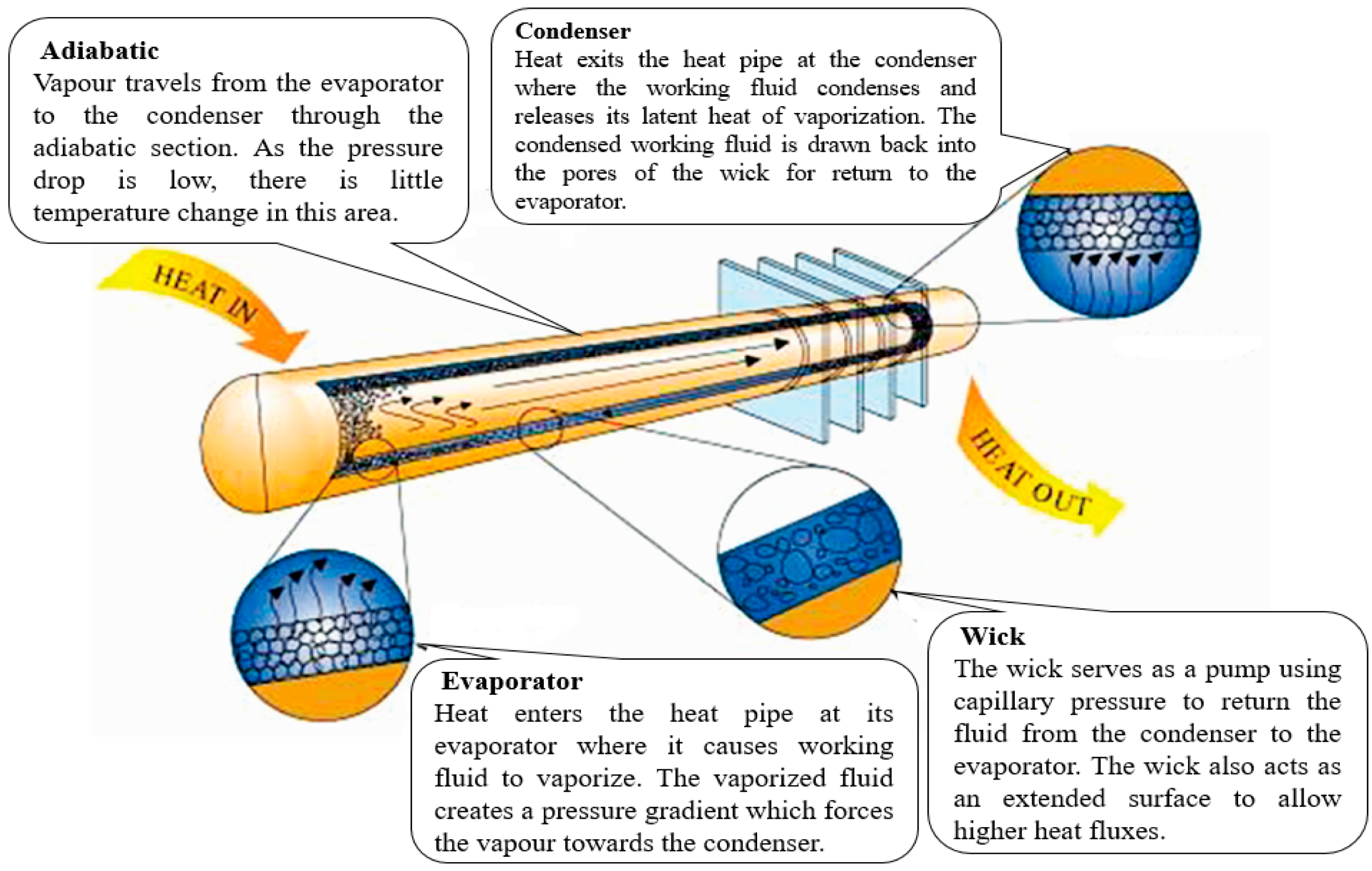
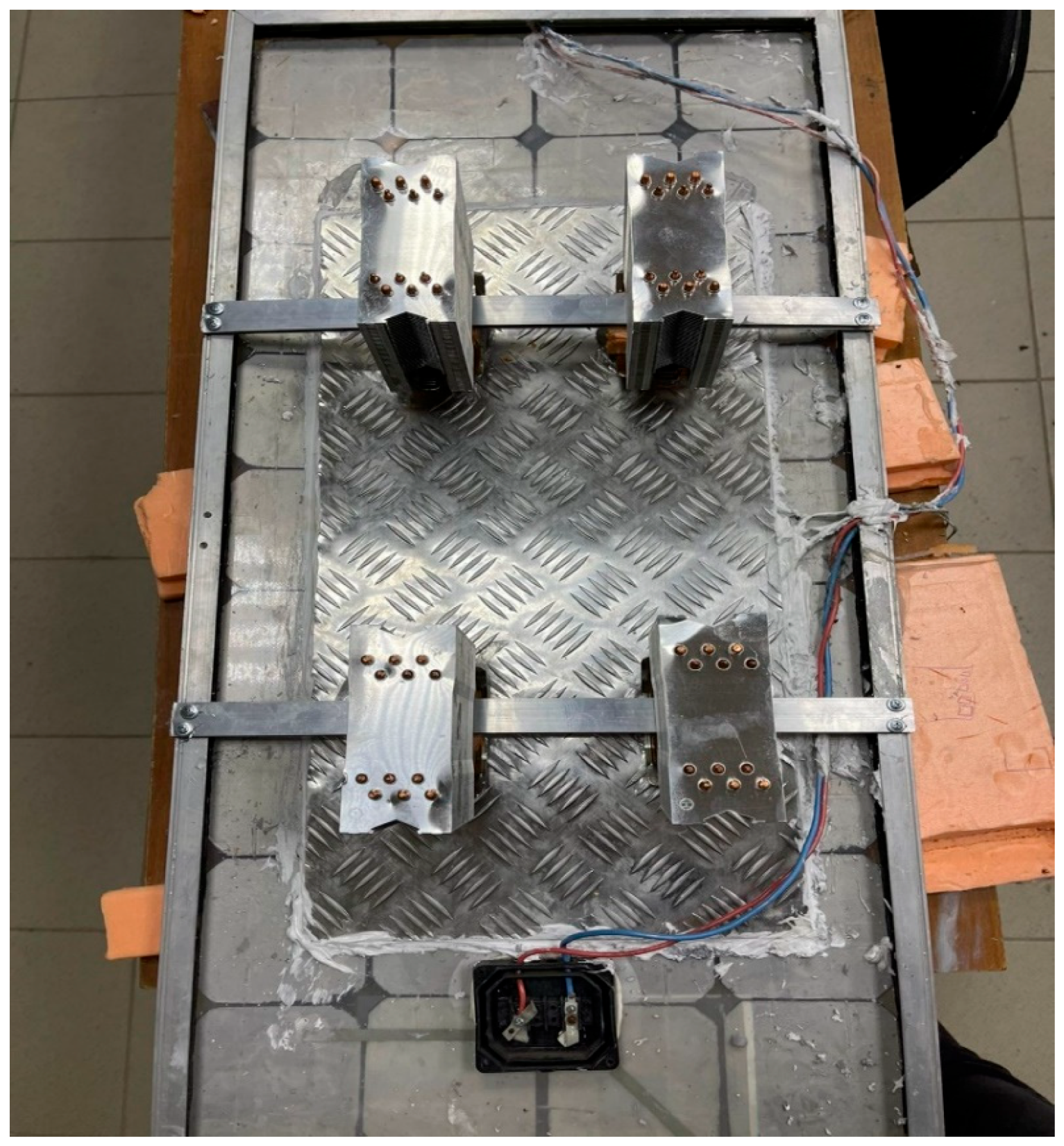


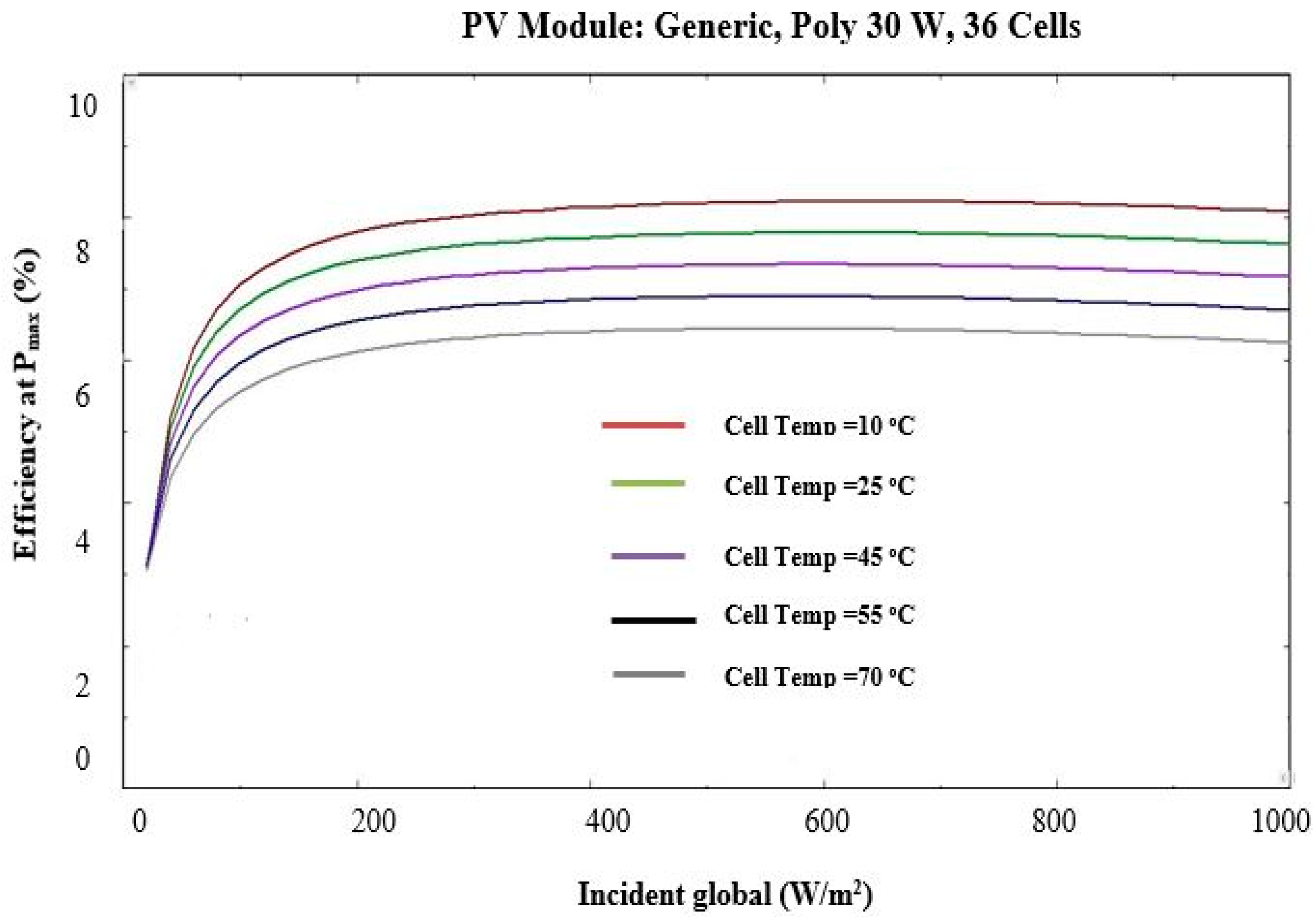
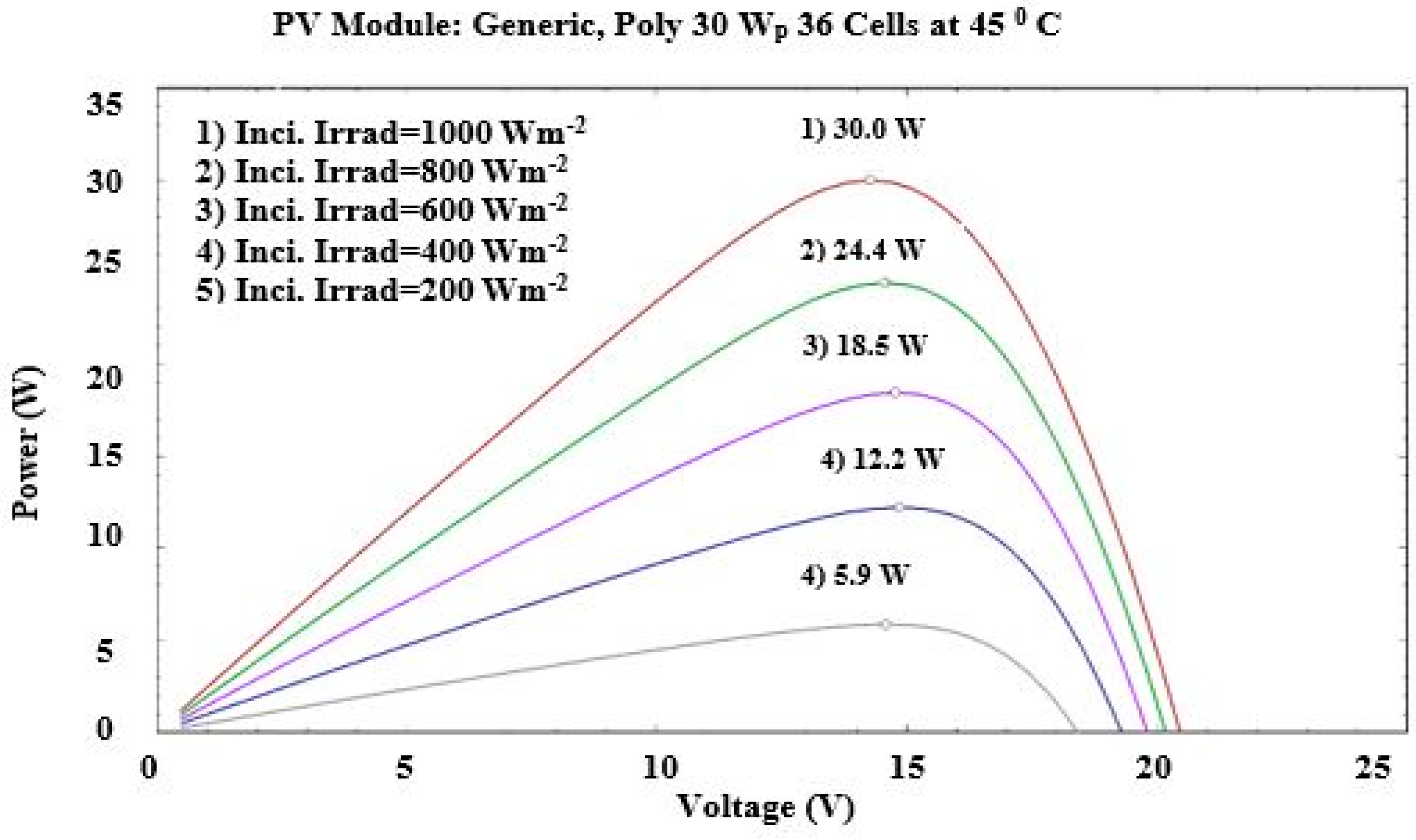




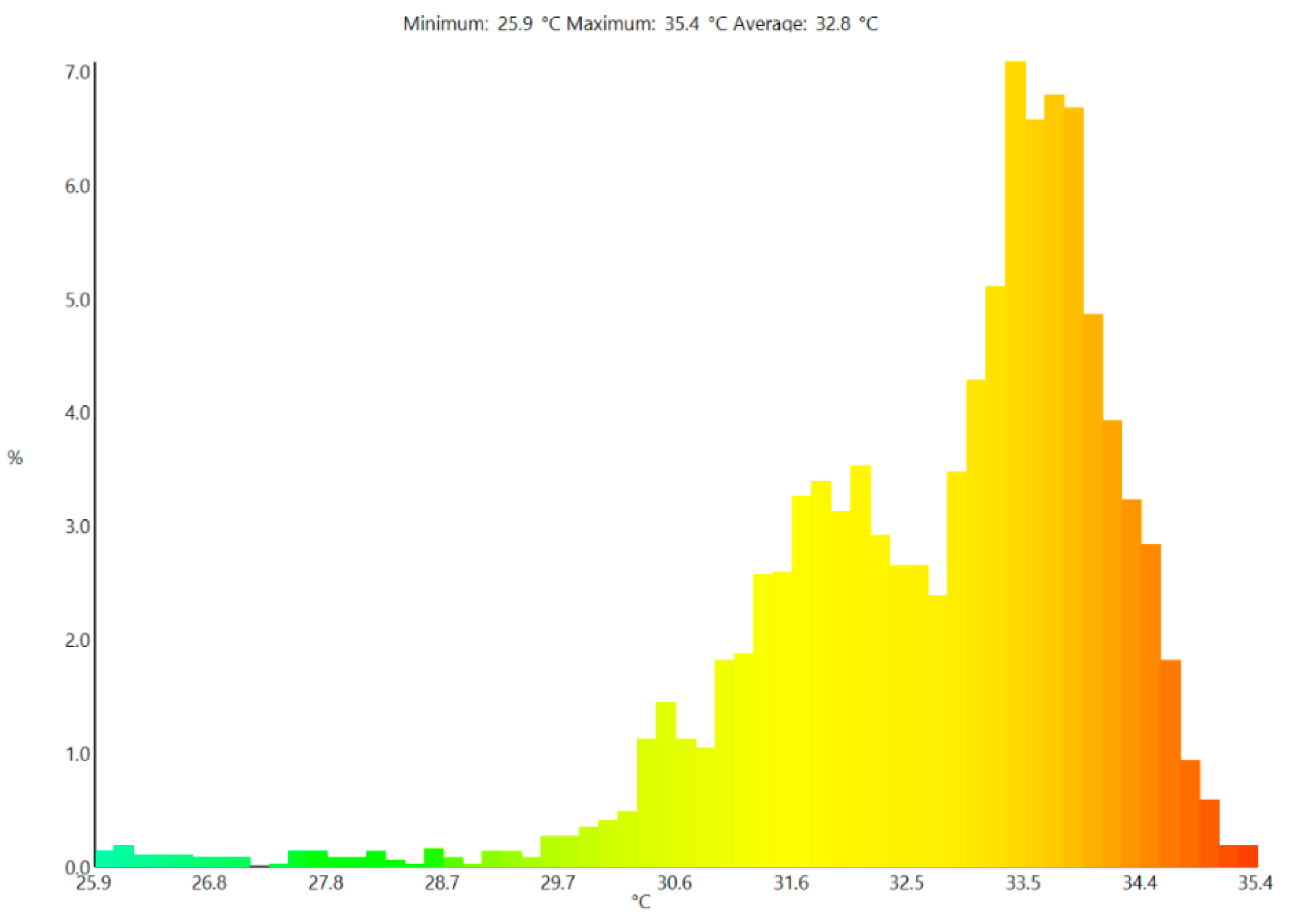

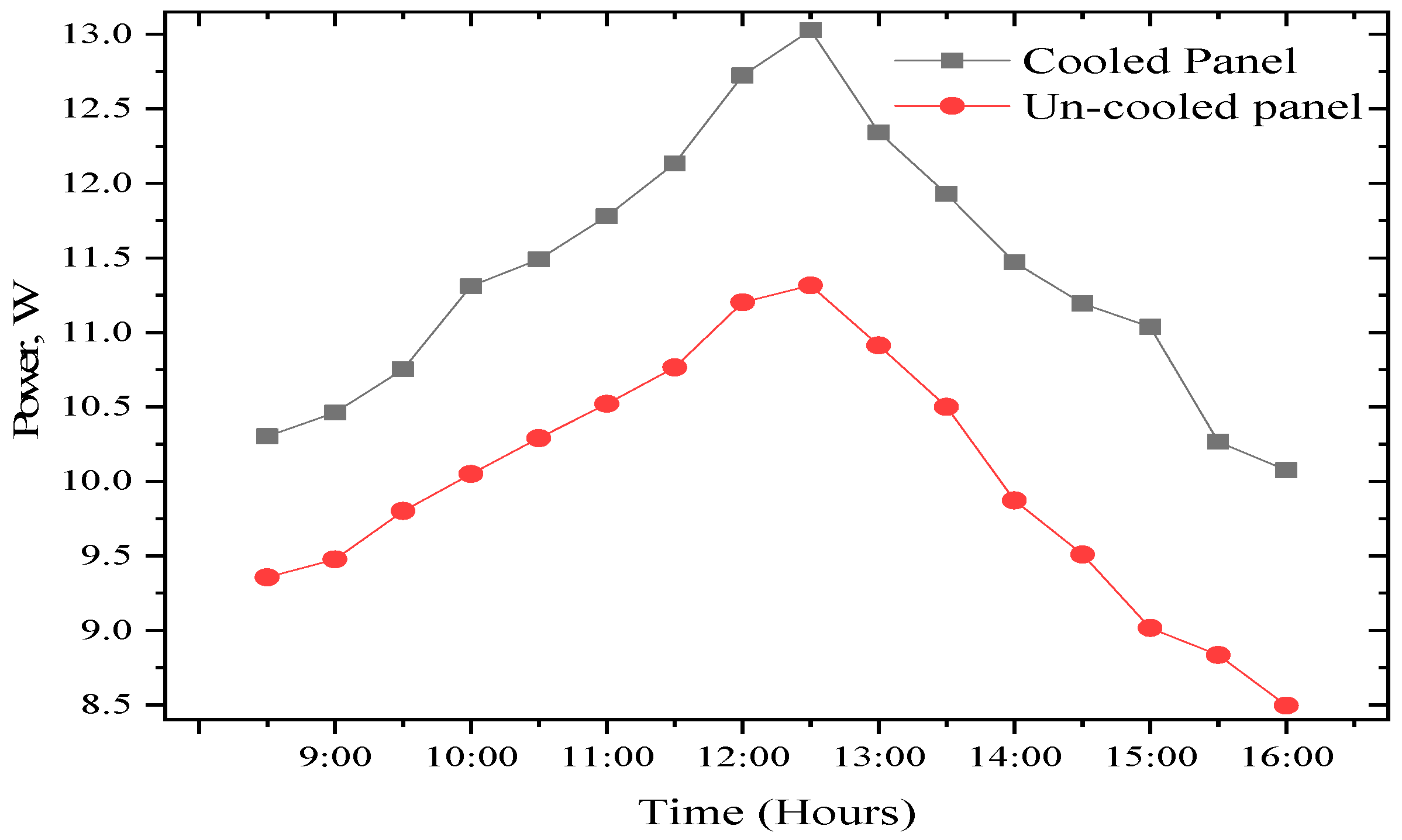
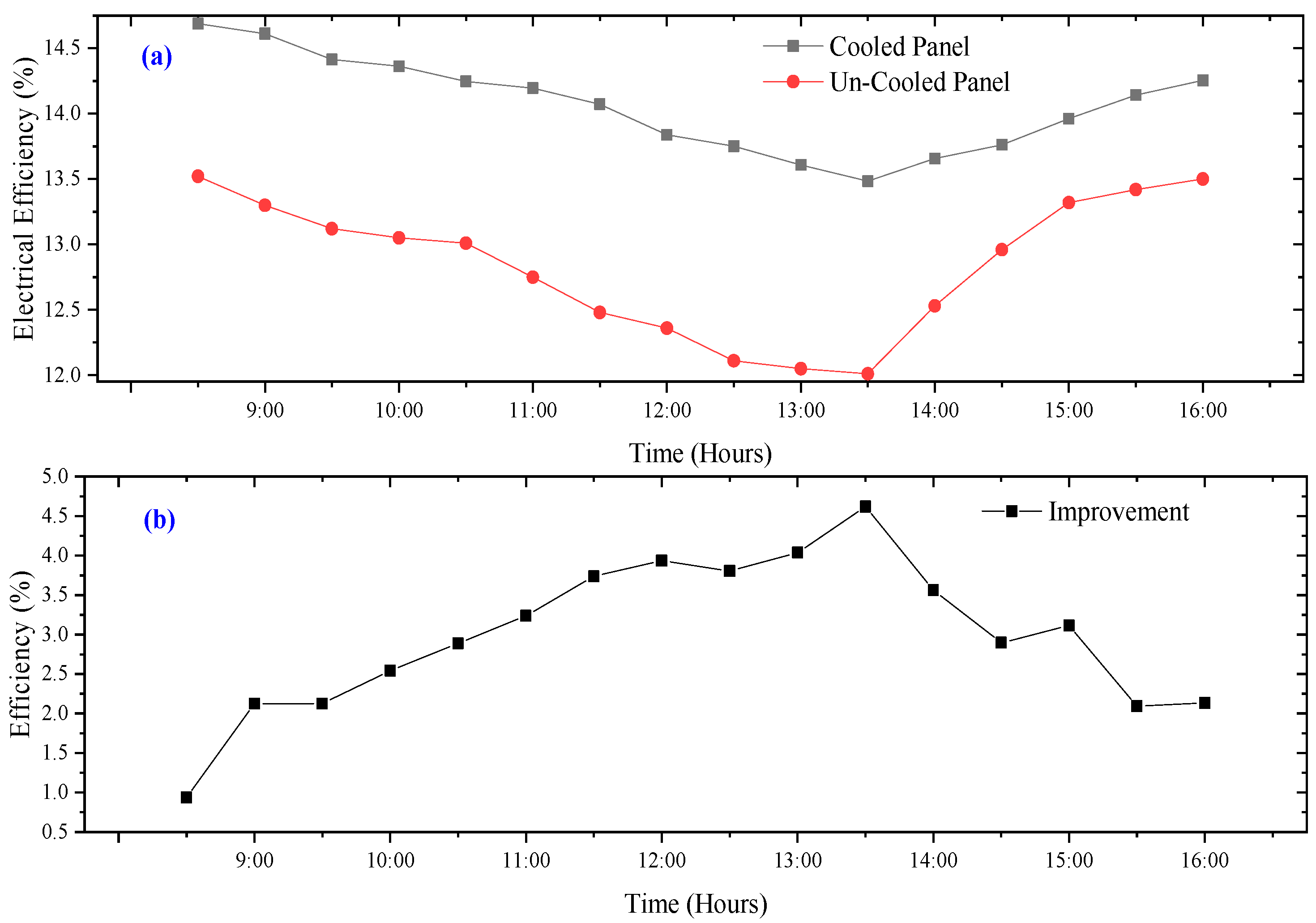

| Specifications | Value |
|---|---|
| Origin | China |
| Model Name | 249761 |
| Manufacturer | Seomic |
| Size (L × W × H), mm | 98 × 95 × 135 |
| Cooling Type | Air Cooler |
| Material | Metal |
| Use | CPU enhance cooling |
| Color | Silver |
| Measurement error | +/−1–3 cm |
| S. No | Instrument | Units | Range | Accuracy (%) | Uncertainty (%) |
|---|---|---|---|---|---|
| 1 | TM-207 Pyranometer | W/m2 | 0–2000 | ±5 | 2.886 |
| 2 | K-Thermocouple | °C | –270 to 1260 | ±0.75 | 0.433 |
| 3 | Clamp Meter | - | ±3% | 1.732 | |
| 4 | Thermometer | °C | −30 to 70 | ±2 | 1.15 |
| 5 | Digital anemometer | m/s | 0–30 | ±3 | 1.732 |
| Reference | Type of Cooling | Proposed Mechanism | Key Results |
|---|---|---|---|
| [82] | Active Cooling | Heat exchanger |
|
| [83] | Active Cooling | PVT |
|
| [84] | Active Cooling | Thermoelectric radiant |
|
| [85] | Active Cooling | Nano-fluid |
|
| [86] | Passive Cooling | Water |
|
| [87] | Active Cooling | Thermo-electric model |
|
| [88] | Active Cooling | Water Heat Exchanger |
|
| [89] | Passive cooling | PCM |
|
| Present Study | Active and Passive Cooling | Fanless CPU Heat Pipe sink with Water |
|
| Items | Cooled PV (USD) | Uncooled PV (USD) |
|---|---|---|
| PV Panel | 50 | 50 |
| Aluminum Sheet | 8 | 0 |
| Fanless heat Pipe sink | 14.25 × 4 = 57 | 0 |
| Thermal grease | 1 | 1 |
| Silicone Gel | 2 | 2 |
| Thermocouples | 2 | 2 |
| Total | 120 | 55 |
| Parameters | Cooled PV | Un-Cooled PV | Reference |
|---|---|---|---|
| Effective discount rate (ieff), % | 5 | 5 | [76] |
| Nominal escalation rate (rn), % | 1 | 1 | [76] |
| KO&M | 0.96 | 0.96 | Calculated |
| Capital recovery factor (CRF) | 0.065 | 0.065 | Calculated |
| Constant escalation levelized factor O&M, (CELF), % | 0.9975 | 0.9975 | Calculated |
| Annual operation and maintenance cost (CO&M), $ | 3.75 | 3.75 | Calculated |
| Lifetime of the years (n), years | 25 | 25 | Assumed |
| Total investment cost (Cinv), $ | 120 | 52 | Calculated |
| Levelized cost of fuel (LCfuel), $/kWh | 0 | 0 | - |
| Component | Quantity | Energy Density (kWh/kg) | Cooled PV Panel (kWh) | Uncooled PV Panel (kWh) |
|---|---|---|---|---|
| PV Panel | 0.4275 m2 | 999 kWh/m2 | 427.5 | 427.5 |
| Aluminum Sheet | 1.5 kg | 4.11 | 6.165 | - |
| CPU Pipe | 0.600 | 8.1 | 4.86 | - |
| Total Embodied Energy (kWh) | - | - | 438.525 | 427.5 |
| Annual Energy (kWh) | - | - | 41.5735 | 35.5145 |
| Energy Payback Time (Yr) | 10.54 | 12.03 |
Publisher’s Note: MDPI stays neutral with regard to jurisdictional claims in published maps and institutional affiliations. |
© 2022 by the authors. Licensee MDPI, Basel, Switzerland. This article is an open access article distributed under the terms and conditions of the Creative Commons Attribution (CC BY) license (https://creativecommons.org/licenses/by/4.0/).
Share and Cite
Praveenkumar, S.; Gulakhmadov, A.; Agyekum, E.B.; T. Alwan, N.; Velkin, V.I.; Sharipov, P.; Safaraliev, M.; Chen, X. Experimental Study on Performance Enhancement of a Photovoltaic Module Incorporated with CPU Heat Pipe—A 5E Analysis. Sensors 2022, 22, 6367. https://doi.org/10.3390/s22176367
Praveenkumar S, Gulakhmadov A, Agyekum EB, T. Alwan N, Velkin VI, Sharipov P, Safaraliev M, Chen X. Experimental Study on Performance Enhancement of a Photovoltaic Module Incorporated with CPU Heat Pipe—A 5E Analysis. Sensors. 2022; 22(17):6367. https://doi.org/10.3390/s22176367
Chicago/Turabian StylePraveenkumar, Seepana, Aminjon Gulakhmadov, Ephraim Bonah Agyekum, Naseer T. Alwan, Vladimir Ivanovich Velkin, Parviz Sharipov, Murodbek Safaraliev, and Xi Chen. 2022. "Experimental Study on Performance Enhancement of a Photovoltaic Module Incorporated with CPU Heat Pipe—A 5E Analysis" Sensors 22, no. 17: 6367. https://doi.org/10.3390/s22176367
APA StylePraveenkumar, S., Gulakhmadov, A., Agyekum, E. B., T. Alwan, N., Velkin, V. I., Sharipov, P., Safaraliev, M., & Chen, X. (2022). Experimental Study on Performance Enhancement of a Photovoltaic Module Incorporated with CPU Heat Pipe—A 5E Analysis. Sensors, 22(17), 6367. https://doi.org/10.3390/s22176367










